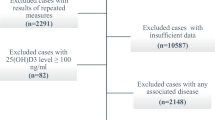Abstract
Vitamin D is synthesized in human skin upon sun exposure and is also a nutrient. It regulates calcium and phosphate metabolism and is essential for the maintenance of bone health. Vitamin D supplementation during infancy, in order to prevent rickets, is universally accepted. Many human cell types carry vitamin D receptor, this being a drive for conducting studies on the possible association between vitamin D status and other diseases. Studies have affirmed that a considerable number of healthy European children may be vitamin D deficient, especially in high-risk groups (darker pigmented skin, living in areas with reduced sun exposure and other disorders). However, the definition of deficiency is unclear due to inter assay differences and due to a lack of consensus as to what is an “adequate” 25(OH)D level. Therefore, there is no justification for routine screening for vitamin D deficiency in healthy children. An evaluation of vitamin D status is justified in children belonging to high-risk groups. All infants up to 1 year of age should receive an oral supplementation of 400 IU/day of vitamin D. Beyond this age, seasonal variation of sunlight should be taken into account when considering a national policy of supplementation or fortification.
Similar content being viewed by others
References
Abrams SA (2016) What does it mean to target specific serum 25-hydroxyvitamin D concentrations in children and adolescents? Am J Clin Nutr 104:1193–1194
Bilinski K, Botyages S (2012) The rise and rise of vitamin D testing. BMJ 345:e4743
Bilinski K, Boyages S (2013) Evidence of over-testing for vitamin D in Australia: an analysis of 4.5 years on MBS data. BMJ Open 3:002955
Braeger C, Campoy C, Colomb V, Decsi T, Domellof M, Fewtrell M et al (2013) Vitamin D in the healthy European paediatric population. JPGN 56:692–701
Cashman KD, Dowling KG, Skrabakova Z, Gonzales Gross M, Valtuena B, De Henauw S et al (2016) Vitamin D deficiency in Europe: pandemic? Am J Clin Nutr 103:1033–1044
Holick MF, Binkley FC, Biscoff-Ferrari HA, Gordon CM, Hanley DA, Heaney RP et al (2011) Evaluation, treatment and prevention of vitamin D deficiency: an endocrine society practice guideline. J Clin Endocrinol Metab 96:1911–1930
Mimouni FB (2010) Vitamin D status in growing children: should we routinely screen for vitamin D deficiency? JPGN 51(S3):s121–s122
Saggese G, Vierucci F, Boot AM, Czech-Kovalska J, Weber G, Camargo CA et al (2015) Vitamin D in childhood and adolescence: an expert position statement. Eur J Paediatr 174:563–576
Sattar N, Welsh P, Panarelli M, Forouhi NG (2012) Increasing requests for vitamin D measurement: costly, confusing and without credibility. Lancet 379:95–96
Spiro A, Buttriss JL (2014) Vitamin D: an overview of status and intake in Europe. Nutr Bull 39:322–350
Author information
Authors and Affiliations
Corresponding author
Rights and permissions
About this article
Cite this article
Grossman, Z., Hadjipanayis, A., Stiris, T. et al. Vitamin D in European children—statement from the European Academy of Paediatrics (EAP). Eur J Pediatr 176, 829–831 (2017). https://doi.org/10.1007/s00431-017-2903-2
Received:
Accepted:
Published:
Issue Date:
DOI: https://doi.org/10.1007/s00431-017-2903-2




